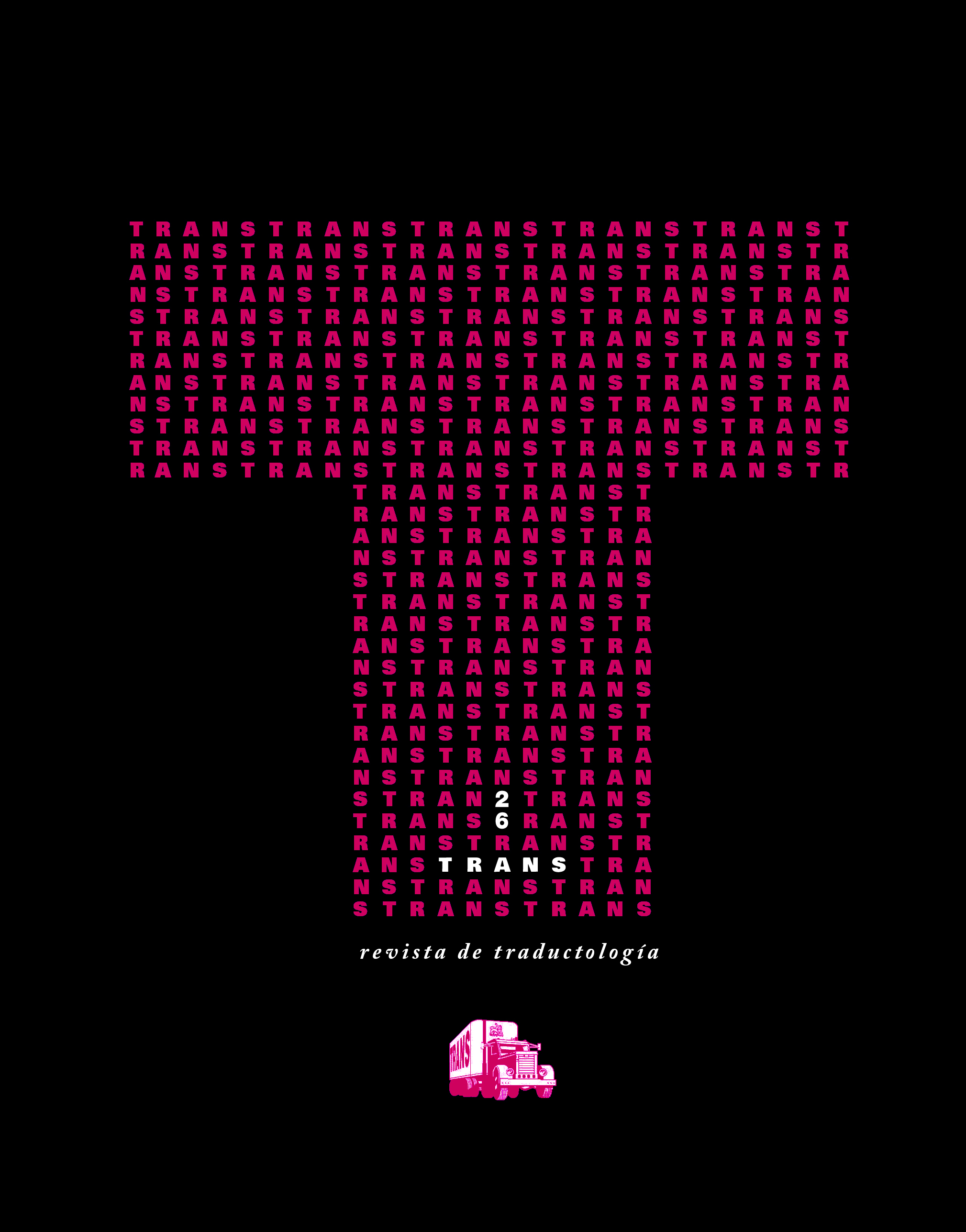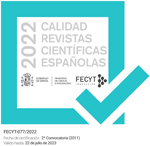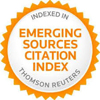Simplification in specialized and non-specialized discourse: Broadening CBTS to multi-discourse analysis
DOI:
https://doi.org/10.24310/TRANS.2022.v26i1.13759Palabras clave:
estudios de traducción basados en corpus, universales de traducción, simplificación, discurso académico, análisis multidiscursivoResumen
Este estudio pretende enriquecer la investigación sobre la hipótesis de simplificación analizándola en distintos tipos de discurso. El objetivo principal es identificar semejanzas y diferencias entre discurso no-especializado y especializado académico en cuanto a la tendencia a la simplificación sintáctica y estilística. La introducción de dos variables en el estudio (discurso no-especializado/especializado académico y textos originales/traducidos) permite determinar cuál tiene una mayor influencia en la tendencia a la simplificación. Tras compilar cuatro corpus de textos ingleses que representan el discurso no-especializado y especializado académico en sus versiones originales y traducidas, se determinaron los rasgos lingüísticos relacionados con la simplificación (variedad léxica, densidad léxica, longitud oracional promedio, hipotaxis, oraciones no finitas) y se identificaron en cada conjunto mediante una metodología de corpus. La comparación de los resultados muestra que, si bien ambos tipos de discursos presentan una tendencia hacia la simplificación, cada uno presenta rasgos lingüísticos distintos, lo que sugiere una mayor relación de dicha tendencia con el tipo de discurso que con la naturaleza original o traducida de los textos.
Descargas
Métricas
Publicación Facts
Perfil de revisores N/D
Información adicional autores
Indexado: {$indexList}
-
Indexado en
- Sociedad Académica/Grupo
- N/D
- Editora:
- Universidad de Málaga
Citas
Anthony, L. (2014). AntConc (Version 3.4.1) (Computer Software). Waseda University. http://www.laurenceanthony.net/
Baker, M. (1993). Corpus Linguistics and Translation Studies: Implications and Applications. In M. Baker, G. Francis, & E. Tognini-Bonelli (Eds.). Text and technology: In Honour of John Sinclair (pp. 233-250). John Benjamins.
Baker, M. (1995). Corpora in translation studies: An overview and some suggestions for future research. Target 7(2), 223-243.
Baker, M. (2004). A corpus-based view of similarity and difference in translation. International Journal of Corpus Linguistics, 9(2), 167-193.
Bennet, K. (2007). Epistemicide! The tale of a predatory discourse. The Translator 13(2), 151-169.
Biber, D., and Gray, B. (2010). Challenging stereotypes about academic writing: Complexity, elaboration, explicitness. Journal of English for Academic Purposes, 9(1), 2-20.
Biber, D., and Gray, B. (2019). Are law reports an ‘agile’ or an ‘uptight’ register?: Tracking patterns of historical change in the use of colloquial and complexity features. In T. Fanego, and P. Rodríguez-Puente (Eds.). Corpus-based Research on Variation in English Legal Discourse (pp. 149-169). John Benjamins.
Blum, S., and Levenston, E. A. (1978). Universals of lexical simplification. Language learning, 28(2), 399-415.
Bunton, D. (1999). The use of higher level metatext in PhD theses. English for Specific Purposes, 18(Supplement 1), S41-S56
Cabré, M. T. (2002). Textos especializados y unidades de conocimiento: metodología y tipologización. In J. García Palacios, and M. T. Fuentes (Eds.). Texto, terminología y traducción (pp. 15-36). Almar.
Cabré, M. T., Da Cunha, I., Sanjuan, E., Torres-Moreno, J. M., and Vivaldi, J. (2010). Automatic specialized vs. non-specialized texts differentiation: a first approach. Technological innovation in the teaching and processing of LSP, hal-02556652. https://hal.archives-ouvertes.fr/hal-02556652
Chen, X., Yan, Y., and Hu, J. (2019). A corpus-based study of Hillary Clinton’s and Donald Trump’s linguistic styles. International Journal of English Linguistics, 9(3), 13-22 https://doi.org/10.5539/ijel.v9n3p13
Chesterman, A. (2004). Beyond the particular. In A. Mauranen, and P. Kujamäki (Eds.). Translation universals: Do they exist? (pp. 33-49). John Benjamins.
Corpas Pastor, G., Mitkov, R., Afzal, N., and Pekar, V. (2008). Translation universals: do they exist? A corpus-based NLP study of convergence and simplification. In MT at Work. Proceedings of the Eighth Conference of the Association for Machine Translation in the Americas (pp. 75-81). Association for Machine Translation in the Americas.
Da Cunha, I., and Montané, M.A. (2020). A corpus-based analysis of textual genres in the administration domain. Discourse Studies, 22(1), 3-31. https://doi.org/10.1177/1461445619887538
Dang, T.N.Y. (2022). A corpus-based study of vocabulary in conference presentations. Journal of English for Academic Purposes, 59. https://www.sciencedirect.com/science/article/abs/pii/S1475158522000649
Del Rey Quesada, S. (2015). Universales de la traducción e historia de la lengua: algunas reflexiones a propósito de las versiones castellanas de los Colloquia de Erasmo. Iberoromania, 81(1), 83-102.
De Sutter, G., and Lefer, M.A. (2019). On the need for a new research agenda for corpus-based translation studies: a multi-methodological, multifactorial and interdisciplinary approach. Perspectives, 28(1), 1-23. https://doi.org/10.1080/0907676X.2019.1611891
Dirección General de Educación Básica (1979). El lenguaje en la educación preescolar y ciclo preparatorio. Vasco-castellano. Centro de Publicaciones. Ministerio de Educación y Ciencia.
Durán-Muñoz, I. (2019). Adjectives and their keyness: a corpus-based analysis of tourism discourse in English. Corpora, 14(3), 351-378.
Even-Zohar, I. (1990). Introduction to Polysystem Studies. Poetics Today, 11(1), 1-6.
Flower, L. (1990). Negotiating Academic Discourse. In L. Flower, V. Stein, J. Ackerman, M. Kantz, K. McCormick, and W. C. Peck (Eds.). Reading-to-write: Exploring a cognitive and social process (pp. 222-252). Oxford University Press.
Gandin, S. (2009). Linguistica dei corpora e traduzione: definizioni, criteri di compilazione e implicazioni di ricerca dei corpora paralleli. AnnalSS, 5, 133-152.
Gotti, M. (2008). Investigating specialized discourse. Peter Lang.
Hernández García, V. (2021). Retos de traducción de las terms and conditions de las redes sociales: análisis jurídico y terminológico contrastivo inglés-español basado en corpus. Hikma 20(1), 125-156.
Huddleston, R., and Pullum, J. K. (2005). A Student’s Introduction to English Grammar. Cambridge University Press.
Kenny, D. (2001). Lexis and creativity in translation: A corpus-based approach. St. Jerome.
Kruger, H., and Rooy, B. (2012). Register and the features of translated language. Across Languages and Cultures, 13(1), 33-65.
Laviosa, S. (1997). How comparable can comparable corpora be? Target, 9(2), 289-319.
Laviosa, S. (1998a). Core Patterns of Lexical Use in a Comparable Corpus of English Narrative Prose. META: Translators’ Journal, 43(4), 557-570.
Laviosa, S. (1998b). Universals of Translation. In M. Baker, K. Malmkjaer, and G. Saldanha (Eds.). Routledge encyclopedia of translation studies (pp. 288-291). Routledge.
Laviosa, S. (2002). Corpus-based translation studies: Theory, findings, applications. Rodopi.
Malmkjaer, K. (1997). Punctuation in Hans Christian Andersen’s stories and in their translations into English. In F. Poyato (Ed.). Nonverbal communication and translation: New perspectives and challenges in literature, interpretation and the media (pp. 151-162). John Benjamins.
Malmkjaer, K. (1998). Love thy neighbour: Will parallel corpora endear linguists to translators? Meta: Translators’ Journal, 43(4), 534-541.
Mattioli, V. (2014). Identificación y clasificación de culturemas y procedimientos traductores en el archivo de textos literarios LIT_ENIT_ES: un estudio de corpus (Master thesis). Universitat Jaume I. http://repositori.uji.es/xmlui/bitstream/handle/10234/112279/TFM_Mattioli_Virginia.pdf?sequence=4
Mattioli, V. (2018). Los extranjerismos como referentes culturales en la literatura traducida y la literatura de viajes: propuesta metodológica y análisis traductológico basado en corpus (PhD thesis). Universitat Jaume I. https://www.tdx.cat/bitstream/handle/10803/587106/2019_Tesis_Mattioli_Virginia.pdf?sequence=1
Mauranen, A. (2004). Corpora, universals, and interference. In A. Mauranen and P. Kujamäki (Eds.). Translation universals: Do they exist? (pp. 65-82). John Benjamins.
Mauranen, A., and Ventola, E. (1996). Academic writing: Intercultural and textual issues. John Benjamins.
Olohan, M. (2002). Corpus linguistics and translation studies: Interaction and reaction. Linguistica Antverpiensia, 1, 419-429.
Ortego Antón, M. T. (2019). La terminología del sector agroalimentario (español-inglés) en los estudios contrastivos y de traducción especializada basados en corpus: los embutidos. Peter Lang.
Paltridge, B. (2002). Thesis and dissertation writing: an examination of published advice and actual practice. English for Specific Purposes, 21(2), 125-143.
Pápai, V. (2004). Explicitation: A universal of translated text? In A. Mauranen & P. Kujamäki (eds) Translation universals: Do they exist? (pp. 143-164). John Benjamins.
Paré A. (2017). Re-thinking the dissertation and doctoral supervision/Reflexiones sobre la tesis doctoral y su supervisión. Infancia y Aprendizaje, 40(3), 407-428.
Pramoolsook, I. (2009). Three fundamental concepts for genre transfer studies: A case of postgraduate dissertation to research article. Suranaree J. Soc. Sci., 3(1), 113-130.
Puurtinen, T. (2003). Genre-specific features of Translationese? Linguistic differences between translated and non-translated Finnish children’s literature. Literary and Linguistic Computing, 18(4), 389-406.
Redelinghuys, K., and Kruger, H. (2015). Using the features of translated language to investigate translation expertise: A corpus-based study. International Journal of Corpus Linguistics, 20(3), 293-325.
Rojo, G. (2002). Sobre la Lingüística basada en el análisis de corpus. UZEI Hizkuntza-corpusak. Oraina eta geroa (2002-10-24/25). http://uzei.com/Modulos/UsuariosFtp/Conexion/archivos54A.pdf.
Sánchez Pérez, A. (1995). Definición e historia de los corpus. In A. Sánchez, R. Sarmiento, P. Cantos, and J. Simón (Eds.). Cumbre: corpus lingüístico del español contemporáneo: fundamentos, metodología y aplicaciones. SGEL.
Sánchez Ramos, M. M. (2019). Corpus paralelos y traducción especializada: ejemplificación de diseño, compilación y alineación de un corpus paralelo bilingüe (inglés-español) para la traducción jurídica. Lebende Sprachen, 64(2), 269-285. https://doi.org/10.1515/les-2019-0015.
Scott, M. (2017). WordSmith Tools version 7. Stroud: Lexical Analysis Software. http://lexically.net/wordsmith/
Seghiri, M., and Arce Romeral, L. (2021). La traducción de contratos de compraventa inmobiliaria: un estudio basado en corpus aplicado a España e Irlanda. Peter Lang.
Several Authors (Cambridge University Press). (2020). English Grammar of Cambridge Dictionary. https://dictionary.cambridge.org/grammar/british-grammar/.
Several Authors (St Mt San Jacinto College) (2020). Prepositions and conjunctions. https://www.msjc.edu/learningresourcecenter/mvc/mvcwritingcenter/documents/handouts/Prepositions-and-Conjunctions.pdf.
Stubbs, M. (1986). Lexical density: A computational technique and somefindings. In M. Coulthard (Ed.). Talking about text (pp. 27-48). University of Birmingham.
Tognini-Bonelli, E. (2001). Corpus linguistics at work. John Benjamins.
Toury, G. (1991). What are descriptive studies in translation likely to yield apart from isolated description? In K. Leuven-Zwart, T. Naaijkens, A. Bernardus, M. Naaijkens (Eds.). Translation Studies: The State of the Art. Proceedings from the First James S. Holmes Symposium on Translation Studies (pp. 179-192). Rodopi.
Un-udom, S., and Un-udom, N. (2020). A corpus-based study on the use of reporting verbs in applied linguistics articles. English Language Teaching 13(4), 162-169.
Venuti, L. (1995). The Translator’s Invisibility. Routledge.
Xiao, R. (2010). How different is translated Chinese from native Chinese? A corpus-based study of translation universals. International Journal of Corpus Linguistics, 15(1), 5-35.
Xiao, R., and Yue, M. (2009). Using corpora in translation studies: The state of the art. In P. Baker (Ed.). Contemporary Corpus Linguistics (pp. 237-262). Continuum.
Yang, X. (2018). A corpus-based study of modal verbs in Chinese learners’ academic writing. English Language Teaching, 11(2), 122-130.
Zanettin, F. (2013). Corpus methods for descriptive translation studies. Procedia: Social and Behavioral Sciences, 95, 20-32.
Publicado
Cómo citar
Número
Sección
Licencia
Todos los contenidos publicados en TRANS. Revista de Traductología están sujetos a la licencia Creative Commons Reconocimento-NoComercia-Compartirigual 4.0 cuyo texto completo puede consultar en <http://creativecommons.org/licenses/by-nc-sa/4.0>
Se pueden copiar, usar, difundir, transmitir y exponer públicamente, siempre que:
- Se cite la autoría y la fuente original de su publicación (revista, editorial y URL de la obra).
- No se usen para fines comerciales.
- Se mencione la existencia y especificaciones de esta licencia de uso.
- Compartir Igual — Si remezcla, transforma o construye sobre el material, debe distribuir sus contribuciones bajo la misma licencia que el original.
Los derechos de autor son de dos clases: morales y patrimoniales. Los derechos morales son prerrogativas perpetuas, irrenunciables, intransferibles, inalienables, inembargables e imprescriptibles. De acuerdo con la legislación de derechos de autor, TRANS. Revista de Traductología reconoce y respeta el derecho moral de los autores/as, así como la titularidad del derecho patrimonial, el cual será cedido a la Universidad de Málaga para su difusión en acceso abierto. Los derechos patrimoniales, se refieren a los beneficios que se obtienen por el uso o divulgación de las obras. TRANS. Revista de Traductología se publica en open access y queda autorizada en exclusiva para realizar u autorizar por cualquier medio el uso, distribución, divulgación, reproducción, adaptación, traducción o transformación de la obra.
Es responsabilidad de los autores/as obtener los permisos necesarios de las imágenes que están sujetas a derechos de autor.
Los autores/as cuyas contribuciones sean aceptadas para su publicación en esta revista conservarán el derecho no exclusivo de utilizar sus
contribuciones con fines académicos, de investigación y educativos, incluyendo el auto-archivo o depósito en repositorios de acceso abierto de cualquier tipo.













21.png)
